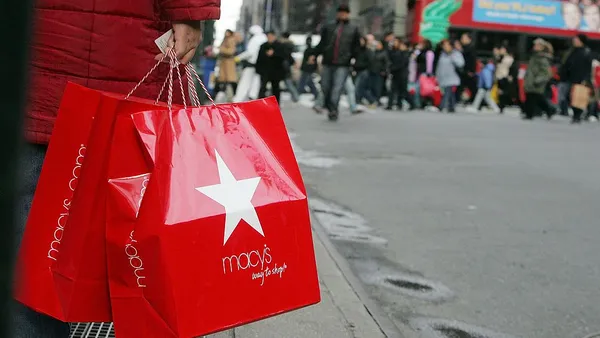Dive Brief:
- The 2019 holiday sales season may have been the "most promotional holiday since the recession," according MKM Partners Managing Director Roxanne Meyer.
- Discounts had several drivers: a shift in consumer preferences toward off-pricers, inventory pileups at department stores, "self-inflicted merchandise issues at select retailers" and "a shortened holiday season [that] resulted in a selling environment that was overwhelmingly competing on price from start to finish," Meyer wrote in a client note emailed to Retail Dive.
- She added that "retailers chose not to take their foot off the promotional gas" after Black Friday week and "Cyber Monday week," a new development since last year. The markdown events, plus a shortened season, meant that discounting continued through the first half of December.
Dive Insight:
Analysts have been expecting plenty of discounts during the fourth quarter. Moody's analysts warned in December that the six fewer selling days between Thanksgiving and Christmas could "exacerbate the promotional environment" for the period. They noted, as an example, that Kohl's in its third quarter already demonstrated that. The analysts pointed all this out as they slashed their expectations, for the second time in months, for department store profits in 2019.
Meyer also highlighted the toll the season took on department stores and their neighbors in malls. "The deals we saw on designer product (on down) were shocking and reflected the extent of dislocation, particularly in the department store segment, which carried over to select mall-based retailers and online retailers as well that were forced to compete on price for the same merchandise," she wrote.
Department stores, others that sell third-party apparel and those that started the season with merchandise issues, among others, were all most vulnerable to softer sales and margins during the period, Meyer added.
But she also noted that "not every retailer needed to participate in the promotional fray." She called out Lululemon, describing the athleisure seller as "the ultimate standout," with no discounts beyond its in-store and online clearance. That strategy was supported by "[s]trong store traffic, product newness and stronger personalized emails [that] likely supported ongoing momentum," she noted.
Meyer also pointed to off-pricers as gaining market share and "with strength across apparel, home and toys."
For those department stores and apparel sellers forced into price wars, it could mean they'll be carrying their struggles into 2020. Again, the problem could be especially acute for the department store sector, which is heavily reliant on the fourth quarter and went through a series of setbacks in 2019.
Falling sales and margins across the sector are especially troubling given that, as Moody's analysts noted last year, those retailers have made significant investments to keep up with technology and improve their efficiency. Still, Moody's expects the sector's operating income to fall 20% for 2019.














